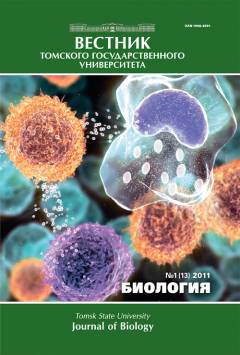The death of birds at highways in Tomsk's environs
The purpose of this work is to estimate the influence of suburban automobile roads having various traffic levels on the death of birds. Investigations were carried out weekly in summertime of 2010 at the model circular part of a road, 43 km in length, in the outskirts of the city of Tomsk. The route went over 3 kinds of road differing in degrees of traffic, surface and in the biotope (landscape) environment. During the investigations the search of the birds killed at the road was carried out; also the count of birds in the 100-meter band along the road and the estimate of their locomotor activity were made. The degree of automobile-load of a road was estimated by the count of the quantity of vehicles per time unit. Altogether 473 km of road surface was investigated, 866 specimens of 43 species of birds were met and 68 dead birds of 13 species were found.Among found dead birds small passerine birds (71,64%) prevailed significantly. By the structure of species the following species prevailed: the chaffinch (Fringilla coelebs L.) (28,36%), the yellow bunting (Emberiza citrinella L.) (13,43%), the white wagtail (Motacilla alba L.) (11,94%), the felt (Turdus pilaris L.) and the tree sparrow (Passer montanus L.) (both 10,45%) and the rock-pidgeon (Colmba livia Gmel.) (8,96%). Other species of the birds were presented by single specimens - the hooded crow (Corvus cornix L.), the magpie (Pica pica L.), the great tit (Parus major L.), the greenfinch (Chloris chloris L.), the pied flycatcher (Ficedula hypoleuca Pall.), the siberian rubythroat (Luscinia calliope Pall.) and the black woodpecker (Dryocopus martius L.).The distribution of the dead birds displayed that the most part of them (56,9%) killed at the sections of roads with adjacent populated areas. The part of birds killed at the sections with adjacent forest-covered areas made up 37,3%. The least quantity of the dead birds registered at the roads with adjacent open areas - 5,8%. Such distributionof the dead birds is explained by birds' possibilities of vision of a road. In the forest and at the populated area the road and moving vehicles are partially closed for the vision by obstacles (trees, human buildings etc). Consequently a bird incorrectly estimates the degree of danger with higher probability. The open areas adjacent to the road provide more perfect vision and let a bird estimate the situation more adequately and avoid collisions with vehicles.The death of birds changed depending on the period of life-cycle. Thus, the most intensive death was observed in the beginning of summer when the birds are feeding up the nestlings. The attractiveness of the road for feed-collecting and a regular run between a nest and the road promoted the maximal death of birds in this period. The death of birds gradually decreases towards August.
Keywords
death of birds, landscape, species of birds, ландшафтное окружение, гибель птиц, виды птицAuthors
| Name | Organization | |
| Koukhta Artyom E. | National Research Tomsk State University | artkuh@mail.tomsknet.ru |
| Moskvitin Sergey S. | National Research Tomsk State University | zoo_tsu@mail.ru |
References

The death of birds at highways in Tomsk's environs | Vestnik Tomskogo gosudarstvennogo universiteta. Biologiya - Tomsk State University Journal of Biology. 2012. № 1 (17).